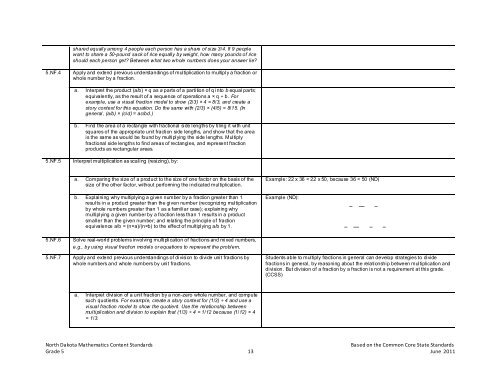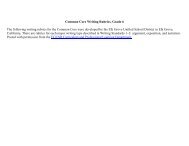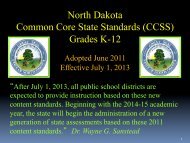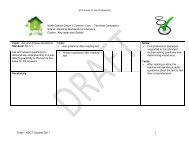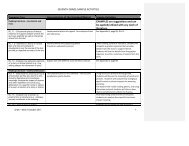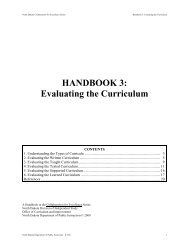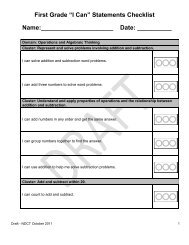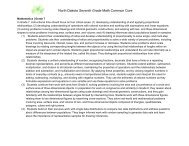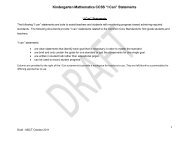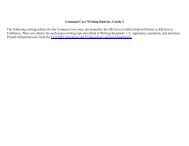A. ND Mathematics Content Standards, Grade 5 - ND Curriculum ...
A. ND Mathematics Content Standards, Grade 5 - ND Curriculum ...
A. ND Mathematics Content Standards, Grade 5 - ND Curriculum ...
Create successful ePaper yourself
Turn your PDF publications into a flip-book with our unique Google optimized e-Paper software.
shared equally among 4 people each person has a share of size 3/4. If 9 people<br />
want to share a 50-pound sack of rice equally by weight, how many pounds of rice<br />
should each person get Between what two whole numbers does your answer lie<br />
5.NF.4<br />
Apply and extend previous understandings of multiplication to multiply a fraction or<br />
whole number by a fraction.<br />
a. Interpret the product (a/b) × q as a parts of a partition of q into b equal parts;<br />
equivalently, as the result of a sequence of operations a × q ÷ b. For<br />
example, use a visual fraction model to show (2/3) × 4 = 8/3, and create a<br />
story context for this equation. Do the same with (2/3) × (4/5) = 8/15. (In<br />
general, (a/b) × (c/d) = ac/bd.)<br />
b. Find the area of a rectangle with fractional side lengths by tiling it with unit<br />
squares of the appropriate unit fraction side lengths, and show that the area<br />
is the same as would be found by multiplying the side lengths. Multiply<br />
fractional side lengths to find areas of rectangles, and represent fraction<br />
products as rectangular areas.<br />
5.NF.5<br />
Interpret multiplication as scaling (resizing), by:<br />
a. Comparing the size of a product to the size of one factor on the basis of the<br />
size of the other factor, without performing the indicated multiplication.<br />
b. Explaining why multiplying a given number by a fraction greater than 1<br />
results in a product greater than the given number (recognizing multiplication<br />
by whole numbers greater than 1 as a familiar case); explaining why<br />
multiplying a given number by a fraction less than 1 results in a product<br />
smaller than the given number; and relating the principle of fraction<br />
equivalence a/b = (n×a)/(n×b) to the effect of multiplying a/b by 1.<br />
Example: 22 x 36 < 22 x 50, because 36 < 50 (<strong>ND</strong>)<br />
Example (<strong>ND</strong>):<br />
5.NF.6<br />
5.NF.7<br />
Solve real-world problems involving multiplication of fractions and mixed numbers,<br />
e.g., by using visual fraction models or equations to represent the problem.<br />
Apply and extend previous understandings of division to divide unit fractions by<br />
whole numbers and whole numbers by unit fractions.<br />
Students able to multiply fractions in general can develop strategies to divide<br />
fractions in general, by reasoning about the relationship between multiplication and<br />
division. But division of a fraction by a fraction is not a requirement at this grade.<br />
(CCSS)<br />
a. Interpret division of a unit fraction by a non-zero whole number, and compute<br />
such quotients. For example, create a story context for (1/3) ÷ 4 and use a<br />
visual fraction model to show the quotient. Use the relationship between<br />
multiplication and division to explain that (1/3) ÷ 4 = 1/12 because (1/12) × 4<br />
= 1/3.<br />
North Dakota <strong>Mathematics</strong> <strong>Content</strong> <strong>Standards</strong><br />
Based on the Common Core State <strong>Standards</strong><br />
<strong>Grade</strong> 5 13 June 2011


